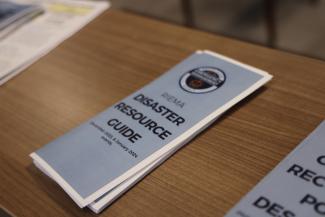Individual Assistance

Individual assistance is for qualified homeowners/renters whose primary residence was damaged or destroyed in a declared designated area. Individual assistance will not compensate you for your entire loss from a disaster, and it is not a replacement for home, renters or flood insurance. The Federal Emergency Management Agency (FEMA) administers the Individual Assistance (IA) Program.
After the President declares a disaster, FEMA may provide money and direct services to survivors affected by a presidentially declared disaster. To be eligible, survivors must be U.S. citizens, non-citizen nationals and qualified aliens.
Survivors have 60 days to apply for disaster assistance from FEMA. Damage to your primary residence and you live in the county designated for FEMA IA, you may be eligible for FEMA assistance. IA are for essential repairs to make a home safe, accessible, and functional.
Individual Assistance Program and Policy Guide
The FEMA Individual Assistance Program and Policy Guide is FEMA's comprehensive policy resource for its Individual Assistance (IA) programs. It outlines the types of assistance available under various FEMA programs, eligibility criteria, application processes, and frequently asked questions.
Do’s and Don'ts of Disaster Assistance
- Survivors must be U.S. citizens, non-citizen nationals, and qualified aliens.
- Damage to your primary residence in the county designated for IA.
- Home Repair or Replacement Assistance, FEMA will confirm residence ownership, rental or lease agreement.
- FEMA cannot provide disaster assistance for damages covered by other funding sources, such as insurance, donations, or other financial assistance programs.
- If assistance from your insurance or another program does not cover all your disaster-related needs, you may be eligible for help from FEMA.
- Inform FEMA about any insurance coverage you have that addresses your disaster-related needs when you apply for FEMA assistance.
- Provide FEMA with proof of the insurance settlement or a letter explaining that coverage was denied.
- FEMA will not duplicate any benefits or losses.
- Damage must be due to the declared event in a designated county.
- Damage must occur to your primary residence (secondary, vacation, and/or rental homes are not eligible).
- The survivor must permit the residence to be inspected.
- The applicant must show proof of ownership (mortgage statement, deed, and/or title) or residency (utility bill).
- Only one applicant per household/residence is allowed.
- BUSINESSES ARE NON-ELIGIBLE APPLICANTS for Individual Assistance
- Information on common disaster-related rumors and scams
How to Apply
-
Online
- Apply online at DisasterAssistance.gov, then click on “Apply Now” and follow the prompts.
- After you apply, you may create an online account on DisasterAssistance.gov, which will make it easier for you to communicate with FEMA. With a DisasterAssistance.gov account, you can upload documents and check the status of your application from anywhere with an internet connection. Learn how to set up a FEMA online account.
-
FEMA App
- Apply via smartphone by downloading the FEMA app
-
In Person
- FEMA Disaster Recovery Center (DRC)
- A DRC is a temporary office set up after a declared disaster to provide support to impacted areas and communities. This office may assist with the application process, answer questions about your application, and help you submit information to FEMA. Find a local DRC.
-
By Phone
You may call the FEMA Helpline at 800-621-3362 to apply for assistance or check your application status. If you use video relay service, captioned telephone service or others, give FEMA your number assigned for that service.
Additional Resources
- Resource Library for Individual Assistance | FEMA.gov
- Get Assistance After a Disaster | FEMA.gov
- Survivors' Road to Recovery | FEMA.gov
- Individual Assistance | FEMA.gov
- Reforming Individual Assistance: New Benefits and Streamlined Processes to Help Disaster Survivors | FEMA.gov
- Eligibility Criteria for FEMA Assistance | FEMA.gov
- Individual Assistance Program and Policy Guide (IAPPG)
